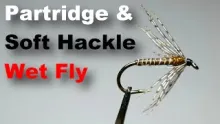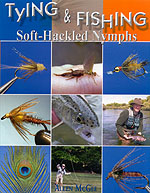When it comes to books, there's nothing I like more than focus. A book that has a well defined subject and covers in depth rather than broad has my vote already before I have opened it.
Image gallery for The North Country FlyUpdated or edited 3 months ago
When it comes to books, there's nothing I like more than focus. A book that has a well defined subject and covers in depth rather than broad has my vote already before I have opened it.
When I then open it and find well structured, thoroughly researched and beautifully presented content from cover to cover, I'm sold!
Such a book is Robert L. Smith's "The North Country Fly".
It concentrates on the simple yet beautiful soft hackle flies of Yorkshire in the UK, flies basically consisting of a body and a hackle. These wonderful and historically significant flies get all the attention anyone could ever dream of, and in an epic swing through centuries, the author takes the reader from the earliest versions of these flies all up to today's presented in a very large section on tying and materials.
There's an immense and impressing amount of systematical and historical data presented, bearing witness to the amount of research that must have been put into this book. Most of the introductory chapters are generously illustrated with reprints and pictures of old documents and journals, and there's a long row of lists throughout the book such as "Joseph Wells 'The Wharfe Dale List'", "North Country Angling Clubs Formation & Association Dates" or the list "A Chronology of North Country Anglers" - the latter just emphasizing what is already pretty obvious when reading through the book: people get credit where credit is due, and it seems to me that no relevant person has slipped under Smith's radar - historic or contemporary.
...people get credit where credit is due.
As the title implies this is a book about flies, and of course it covers flies. Pattern origins, materials and tying. You will find the Orange Partridge, the Waterhen Bloa and other patterns you have heard of and maybe even tied, as well as some lesser known ones. A handful is illustrated with large and beautiful pictures while a much larger number are listed with brief materials lists, which are more than sufficient to enable you to tie these fairly simple flies.
A few of the smaller fly images throughout the book are not quite as well done as most, but have a strange green tint. Never the less the fly images are still beautiful and serve as great illustrations. The illustrations in the section on materials are also very well done and lift these chapters well above the average.
You will also find a large number of charming B/W drawings as well as some lesser charming - but very clear and helpful - computer drawn illustrations of tying techniques.
There is a section on entomology, but luckily not only with the purpose of explaining the natural history of the insects, but also to point out which of these flies can imitate them.
The author included a section on tying techniques (with the above mentioned illustrations), but again with focus on the techniques used for these flies specifically and not a word about whip finishing or stripping herl.
So even when it strays away from the flies, it stays in focus.
Likewise in the fishing chapter. Sure there's an introductory mention of rods and lines, but already at the leaders section, the focus is solely on these flies, how to rig them, present them and how to fish them. The traditional ways of fishing the softhackles are covered through different up and downstream presentations, and Smith talks about the advantages of the angler fishing the delicate wet flies "...gaining an advantage on the blinkered 'Dry Fly' dogmatist." as one quote reads.
As it might have been obvious from the outset of this review, I'm pretty enthused over this book.
It seems to me as a modern landmark in the history of the soft hackles, flymphs and spider style flies on par with "The Art of Tying the Wet Fly and Fishing the Flymph" by Leisenring and Hidy and the classic "North Country Flies" by Thomas Evan Pritt, and for people into this type of flies or fly history in general it's a must-have book.
Its style and content and in particular thoroughness and focus is right after my heart, and it surely deserves a Global Class rating, only missing the Ultra because of some illustrations not being quite on par with the rest of the book.
- Log in to post comments








J,
I wrote the re
J,
I wrote the review, and as I write this I sit with my back turned to a bookshelf with many hundred books on fly-fishing and fly-tying, and compared to most of them this book holds a very high standard.
Coming from a scientific background I know that demands on research can be high and that a given article, paper or book must have "scholastic rigour" and of course be free of errors.
Luckily the world of fly-fishing and fly-tying does not require quite the same standard. A book shouldn't contain errors, but apart from that I'm personally interested in great writing, good presentation, personal views and a writer's ability to entertain, enthuse and educate me.
This book delivers.
My previous knowledge of soft hackles comes from other books and articles, and the few facts I have present do not collide with anything I read in this book. People with more profound knowledge (yourself maybe?) might see errors, missing facts, misleading content and bad research, but gullible as I am, I was impressed and both learned something and was well entertained underway, and no matter what, the amount of work put into this book is enough to impress me, and I'm sure many others would agree. I have seen a few other reviews online, and most seem to be in line with mine.
The book gave me an urge to start tying soft hackles and left me with a very good impression. I stand by my rating.
Martin
This review is far t
This review is far too enthusiastic. Although the book is well presented the it nowhere near deserves Global Class rating that your reviewer suggests nor is it "a modern landmark in the history of the soft hackles". It gives an overall impression of serious research but this is misleading. The historical section lacks scholastic rigour and contains far too many errors and assumptions.
One of the best
Martin,
This book may very well be the finest on the subject. The amount of research Mr.Smith put into this text is prevalent throughout. I find myself reopening this book from time to time... and if you're doing that, you know it's a well written book.
The section about Lister's fly journal is absolutely amazing and when I first read it, gave me chills. I love soft hackle flies and flymphs and I really appreciate the hard work that was done in putting this book together.
It's a shame some people don't realize a good book when they see it.